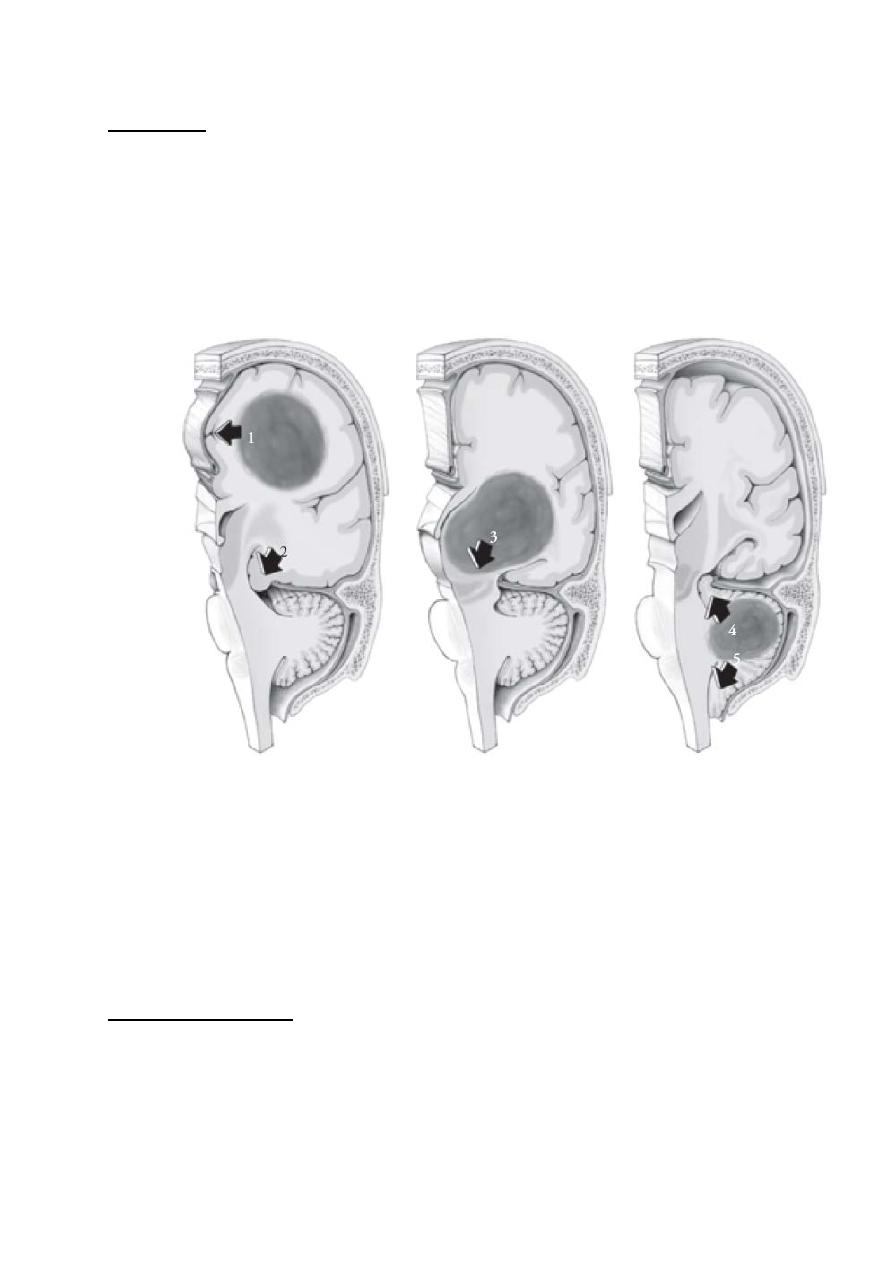
RAISED INTRACRANIAL PRESSURE
Physiology of ICP:
• The skull is a fixed structure not allowing expansion.
• Intracranial volume consists of three compartments: brain, blood, CSF.
If
the volume of one of these compartments increases, the volume of
another must decrease to maintain normal ICP (50-180mm water).
• If the CSF pressure is further increased the brain may begin to herniate,
then cerebral perfusion pressure will drop and ischemia result.
Causes of raised ICP
A. Space-occupying mass, for example, brain tumor, abscess, hematoma.
B.
Brain oedema
C. Hydrocephalus
D. Venous thrombosis: impairs CSF reabsorption
E. Idiopathic intracranial hypertension
Clinical features of raised ICP
a. Headache
b. Morning vomiting
c. Papilloedema
d. Impairment of conscious level
e. Hypertension and bradycardia
f. Transient visual obscurations
g. False localizing signs
h.
Herniation
1

Herniation
• The rise in intracranial pressure from a mass lesion is not usually uniform
within the cerebral substance and alterations in pressure relationships
within the skull may lead to displacement of parts of the brain between its
various compartments (herniation).
• Cerebellar herniation (coning) may result in brain-stem haemorrhage
and/or acute obstruction of the CSF pathways. As coning progresses, the
patient may adopt a decerebrate posture and, unless rapidly treated, death
almost invariably ensues.
• Herniation may be acutely accelerated if the pressure dynamics are
suddenly disturbed by lumbar puncture.
False localising signs
a) Pupillary dilatation
b) 6th cranial nerve lesion (unilateral or bilateral)
c) Hemiparesis
d) Bilateral extensor plantar responses
2

Treatment of Elevated Intracranial Pressure
a) Elevate head of the bed; midline head position
b) Osmotherapy—mannitol or hypertonic saline.
c) Glucocorticoids—dexamethasone 4 mg q6h for vasogenic edema from
tumor, abscess (avoid glucocorticoids in head trauma, ischemic and
hemorrhagic stroke).
d) Hyperventilation
e) High-dose barbiturate therapy ("pentobarb coma")
f) Hypothermia
g) Hemicraniectomy
IDIOPATHIC INTRACRANIAL HYPERTENSION
• This condition usually occurs in obese young women.
• The aetiology is uncertain but there may be a diffuse defect of CSF
reabsorption by the arachnoid villi.
• The condition can be precipitated by drugs, including tetracycline, and
rarely vitamin A, retinoids, Addison's disease and withdrawal of
corticosteroid therapy.
Clinical features
• Characteristically, there is a headache (raised ICP headache), sometimes
with transient diplopia and visual obscurations, but few other symptoms.
• There are usually no signs other than papilloedema, but 6th nerve palsy
may be present.
Investigations
1-Brain CT is normal
2-Lumbar puncture is safe and will allow confirmation of the raised CSF (CSF
manometry) and CSF aspirate.
3-MRV (magnetic resonance venography) to exclude cerebral vein thrombosis
4-Thyroid function test to exclude hypothyroidism.
3

Management
1. Any precipitating condition should be sought and treated.
2. weight-reducing diet
3. The carbonic anhydrase inhibitor, acetazolamide, may help to lower
intracranial pressure.
4. Repeated lumbar puncture and CSF aspirate can be considered, but is
often unacceptable to the patient.
5. Patients failing to respond, in whom chronic papilloedema threatens
vision, may require optic nerve sheath fenestration or a lumbo-peritoneal
shunt.
4
